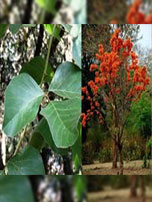SHAHEED KARTAR SINGH SARABHA AYURVEDIC MEDICAL COLLEGE & HOSPITAL
Affiliated to Guru Ravidas Ayurved University, Hoshiarpur Punjab
Affiliated to Guru Ravidas Ayurved University, Hoshiarpur Punjab

Botanical Name : Butea monosperma
Family : Papilionaceae; Fabaceae
Introduction :
It is the most important plants for the Yajna. Its gum (red coloured) is also described in vedic texts. it used in the management of Arsas, Atisãra, Raktapitta, Kustha, Raktaja Gulma etc.
The flame tree belongs to the subfamily Caesalpinioideae, family Fabaceae (formerly Leguminosae).
The Chinese flame tree belongs to the Sapindaceae family and is classified as Koelreuteria bipinnata.
Names in different Indian languages :
English : Flame of the Forest,Butea Gum, Bengal Kino,bastard teak
Hindi : Dhak,palash
Kannada : muttagamara
Malayalam : Plasu,chamata
Sanskrit : palasah
Tamil : Camata,purasus
Telugu : moduga
Unani : Dhaak,Samagh Dhaak,Kamarkas
Folk : Tesu
Synonyms :
Kimsuka, Ksãrarestha, Brahmopanetra, Rakta puspa, Samidvara, Brahma Vrksa, Vãtapotha, Triparni , Paalasha, Kimshuka, Raktapushpaka, Kshaarshreshtha, Brahmavriksha, Samidvar.
B. frondosa Koenig ex Roxb.
Classification according to Charaka, Susrutha & Vagbhata :
Susrutha : Rodhrãdi, Muskakãdi, Ambasthãdi, Nyagrodhãdi
Vagbhata : Rodhrãdi, Muskakãdi, Ambasthãdi, Nyagrodhãdi
Varieties & adulterants – (CV – controversy, AD – adulterants) :
1. Latapalsa – B. superb Roxb
2. Rakta (red),
3. Pita (yellow)
4. Sveta (white)
5. Neela (blue).
Morphology :
A deciduous tree growing up to 15 m. height and 1.5-2 m in girth, trunk is crooked. Bark light-brown or bluish-grey, yielding a ruby-red vitreous gum(Butea gum or Bengal keno) Wood-white or yellow-brown.
Leaves trifoliolate, large, unequal, 10.5-20.5 cm.
Flowers- in racemes, brilliant orange-red, 4-6 cm. long; lower calyx-teeth deltoid.
Fruits- pods, silvery-white, broad, dehiscent (by one suture).
seeds- flat, elliptic, reddish-grey, 3 cm.
Distribution & Habitat :
Throughout India
Chemical constituents :
butin, butrin, isobutrin, palastrin, butrin, coreopsin, monospermoside , sulphurein, chalcones.
Flowers— butin, isocorcopsin, monospermoide, butein (major glucoside), isomonospermoside, coreopsin, palasitrin.
Roots— Glycine, Jalaric esters I, II, III & IV etc
Gum— leucocyanidin, procyanidin etc.
Seeds— monaspermin, palasonin, essential oil with myristic, palmitic acids etc.
Properties :
Rasa- Katu, Tikta, Kasaya
Guna -Laghu, Snigdha
Virya – Usna
Vipaka – Katu
Karma : Vãta-kapha hara, Grãhi, Krmighna, Dipana
Bark—astringent, styptic (prescribed in bleeding piles, ulcers, haemorrhages, menstrual disorders), anthelmintic.
Flowers—astringent, diuretic, emmenagogue (also given for leucorrhoea). A decoction of flowers is given in diarrhoea and haematuria, also to puerperal women.
Seeds—clinical use of seeds as an anthelmintic drug is not considered safe in humans
Indication :
Krimi, Pliha roga, Gulma, Grahani, Arsaas. astringent, bleeding piles, ulcers, haemorrhages (menstrual disorders), anthelmintic. diuretic, emmenagogue (also given for leucorrhoea).Antibacterial,antifungal
Part used :
stem bark, flowers, seeds, gum , ash
Dosage :
Bark decoction 50-100 ml, seed powder 5-8 g, flower powder 5-6 g, gum 2-4 g
Important Yogas or Formulations :
Krmimudgararas, Palãgaksãra taila
Therapeutic Uses :
1. Slipada-Juice of Palãsa root and equal quantity of Sarsapa are given with oil (V.M). .
2. Krimi- Seed paste or juice of Palãsa may be taken with butter milk (S.S.Ut.54)
3. Pumsavana- The pregnant lady (2-3 months after conception) may be given paste of one palasa leave with milk (B. P).
Botanical Name : Nyctanthes arbor-tristis
Family : Oleaceae; Nyctanthaceae
Introduction :
Latin name: Nydanthus (Nyct = night; anthus = flowering (night flowering); arbortristis = (Arbor )
tristis = weeping, gloomy, flowers dropping like tears).
Red stalks of flowers are cut, dried in the sun end stored to be usedfor dying clothes and as a colouring agent for sweets and other eatables. Poets in India have compared the tips of beautiful women to the flowers of this tree
Names in different Indian languages :
English : Tree of Sorrow,Night Jasmine,Coral Jasmine
Hindi : Harsimgar,parja
Kannada : Parijata
Malayalam : Pavilamalli,parijatham
Sanskrit : Paarijaata
Tamil : Pavazha mattigai
Telugu : pavilamalligai
Unani : Harasingaar,swetasarasa
Synonyms :
Paarijaata, Shephaali, Shephaalikaa, Mandaara
Morphology :
A tree of 3 – 10 mtrs height.
Leaves – simple, opposite, facing forwards, 10 to 12.5 cm long. 5 to 6.25 cm broad, rough. Upper surface is green and the lower surface is white. Petals are yellowish red and very attractive in appearance. Therefore it is compared to the lips of a young lady.
Flowers – white, fragrant and delicate, flowers bloom in the night and fall off in the morning on the ground below the tree. Ovary is flat, bilobular with two seeds. (Children play with these seeds and call them as coins).
Distribution & Habitat :
All over India
Chemical constituents :
Iridoid glycosides, mannitol, beta-amyrin, beta-sitosterol, hentriacontane, benzoic acid, astragalin, nicotiflorin, oleanolic acid, nyctanthic acid, friedelin and lupeol.
Properties :
RASA- tikta
GUNA- laghu. ruksha
VIRYA-ushna
VIPAKA-katu
Karma :
bitter tonic, cholagogue, febrifuge, anti-inflammatory, antispasmodic, hypotensive, respiratory stimulant, laxative, diuretic
Indication :
fevers, gout, sciatica, pruritus, cough, asthma
Part used :
Leaves, flower, seed, bark
Dosage :
2-4 g
Internal uses :
Seeds are used as antihelminthics and in alopecia. Rough leaves are used for scrapping the margins of wounds. Leaf juice is used in loss of appetite, piles, liver disorders, biliary disorders and intestinal worms. Powder prepared from leaves or bark is given in cough and asthma. Also useful in dysuria, chronic fever and snake poisoning.
Therapeutic Uses :
Decoction of leaves is very useful in fever with rigors
